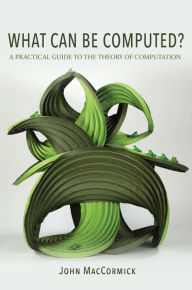-
[Kindle] What Can Be Computed?: A Practical Guide to the Theory of Computation download
What Can Be Computed?: A Practical Guide to the Theory of Computation. John MacCormick

What-Can-Be-Computed-A.pdf
ISBN: 9781400889846 | 408 pages | 11 Mb

- What Can Be Computed?: A Practical Guide to the Theory of Computation
- John MacCormick
- Page: 408
- Format: pdf, ePub, fb2, mobi
- ISBN: 9781400889846
- Publisher: Princeton University Press
Download What Can Be Computed?: A Practical Guide to the Theory of Computation
Download electronic books online What Can Be Computed?: A Practical Guide to the Theory of Computation 9781400889846
What Can Be Computed?: A Practical Guide to the Theory of Computation by John MacCormick An accessible and rigorous textbook for introducing undergraduates to computer science theory What Can Be Computed? is a uniquely accessible yet rigorous introduction to the most profound ideas at the heart of computer science. Crafted specifically for undergraduates who are studying the subject for the first time, and requiring minimal prerequisites, the book focuses on the essential fundamentals of computer science theory and features a practical approach that uses real computer programs (Python and Java) and encourages active experimentation. It is also ideal for self-study and reference. The book covers the standard topics in the theory of computation, including Turing machines and finite automata, universal computation, nondeterminism, Turing and Karp reductions, undecidability, time-complexity classes such as P and NP, and NP-completeness, including the Cook-Levin Theorem. But the book also provides a broader view of computer science and its historical development, with discussions of Turing's original 1936 computing machines, the connections between undecidability and Gödel's incompleteness theorem, and Karp's famous set of twenty-one NP-complete problems. Throughout, the book recasts traditional computer science concepts by considering how computer programs are used to solve real problems. Standard theorems are stated and proven with full mathematical rigor, but motivation and understanding are enhanced by considering concrete implementations. The book's examples and other content allow readers to view demonstrations of--and to experiment with—a wide selection of the topics it covers. The result is an ideal text for an introduction to the theory of computation. An accessible and rigorous introduction to the essential fundamentals of computer science theory, written specifically for undergraduates taking introduction to the theory of computation Features a practical, interactive approach using real computer programs (Python in the text, with Java alternatives online) to enhance motivation and understanding Gives equal emphasis to computability and complexity Includes special topics that demonstrate the profound nature of key ideas in the theory of computation Features a companion website that includes additional materials
Understanding Computation - I Programmer
The reason for the practical introduction to Ruby is that in the rest of the book Ruby is used to implement examples of what are often just theoretical constructs. If you are happy to have ideas explained as just theory then you might well object to the amount of Ruby needed to create programs that do something that you John MacCormick | Dickinson College
Associate Professor of Computer Science. B.A., University of Cambridge, 1993; M.S., University of Auckland, 1996; Ph.D., University of of computer science. New book: What Can Be Computed? A Practical Guide to the Theory ofComputation. This is an undergraduate textbook for a course on Theory ofComputation. Amazon.com: What Can Be Computed?: A Practical Guide to the
Editorial Reviews. From the Back Cover. "This wonderful book explores thetheory of computing from a practical viewpoint. John MacCormick covers the basic concepts of computability and complexity, what we can and cannotcompute--keeping the material grounded by connecting it with Python--the popular programming Computer programming - Wikipedia
The purpose of programming is to find a sequence of instructions that will automate performing a specific task or solving a given problem. The process of programming thus often requires expertise in many different subjects, including knowledge of the application domain, specialized algorithms, and formal logic. Related What Can Be Computed?: A Practical Guide to the Theory of
An accessible and rigorous textbook for introducing undergraduates to computerscience theory. What Can Be Computed? is a uniquely accessible yet rigorousintroduction to the most profound ideas at the heart of computer science. Crafted specifically for undergraduates who are studying the subject for the first time, and What Can Be Computed?: A Practical Guide to the Theory of
Computed? is a uniquely accessible yet rigorous introduction to the most profound ideas at the heart of computer science. Crafted specifically for undergraduates who are studying the subject for the first time, and requiring minimal prerequisites, the book focuses on the essential fundamentals ofcomputer science theoryPdf downloads:
LA RECONQUISTA ESPAÑOLA EN 50 LUGARES JOSE IG DE LA TORRE RODRÍGUEZ ePub gratis
[Kindle] A Curious History of Sex download
-
Commentaires
